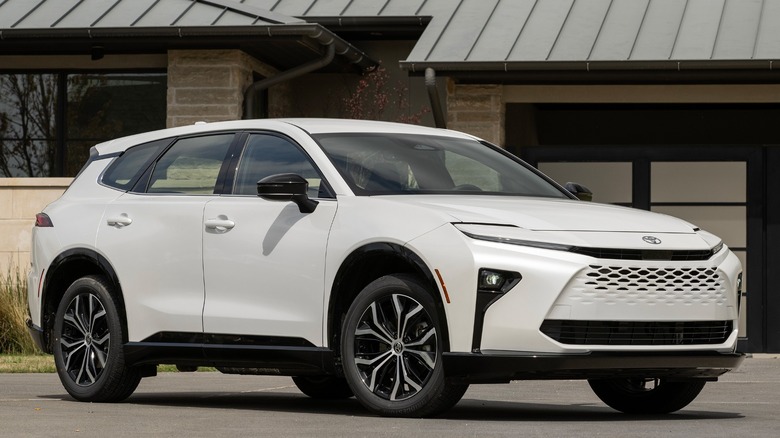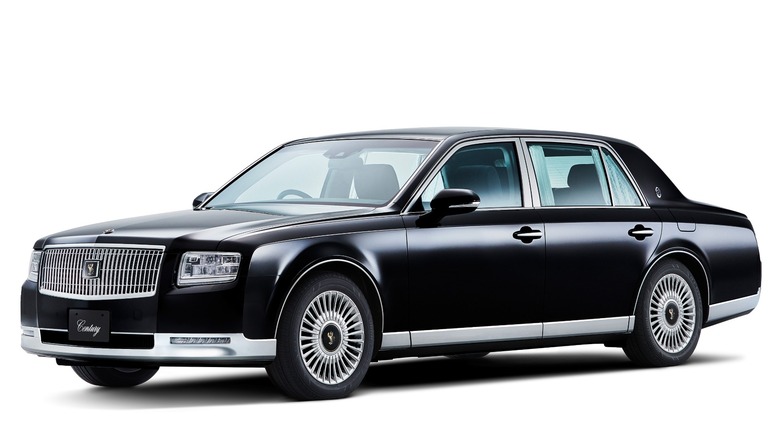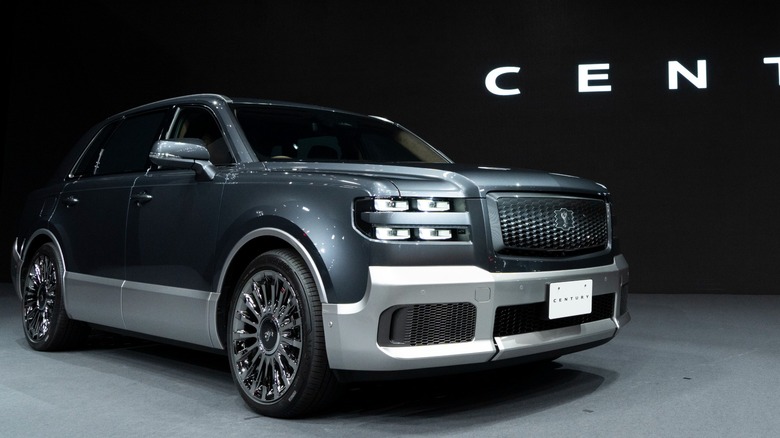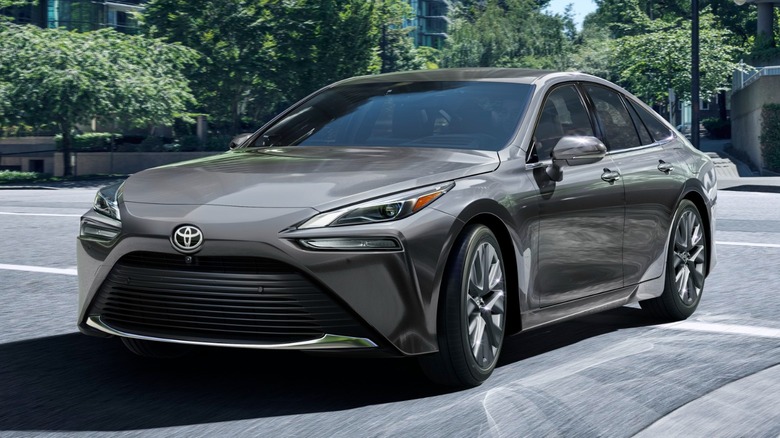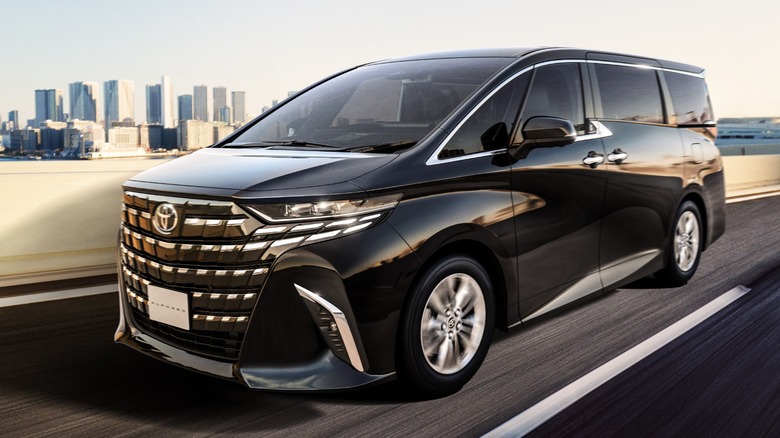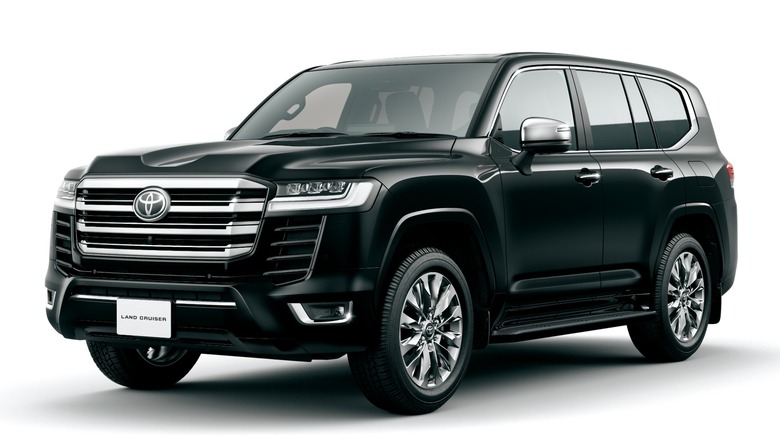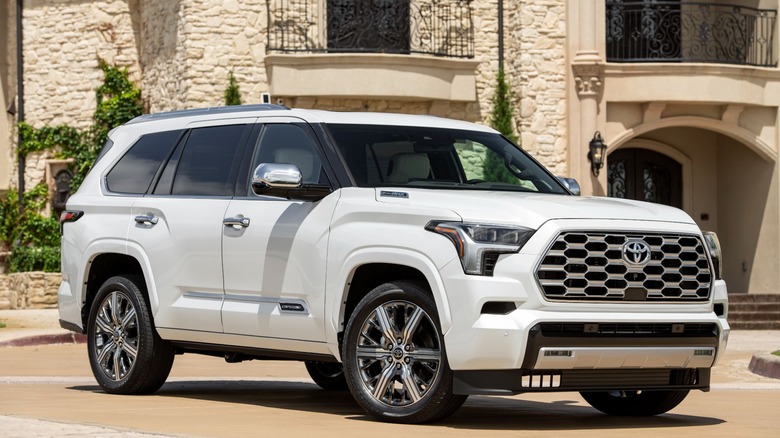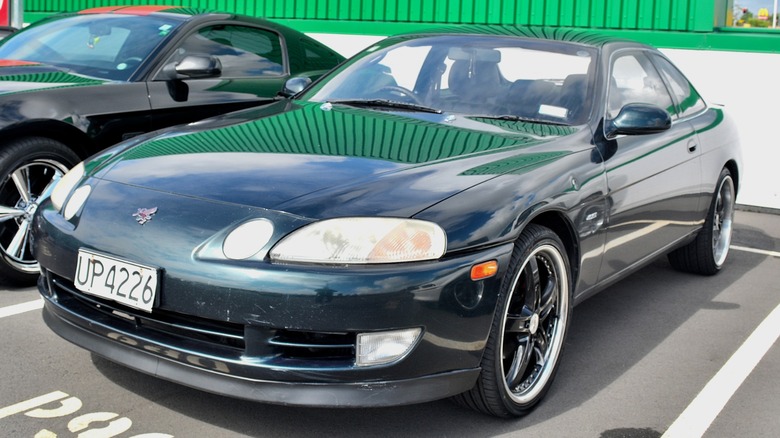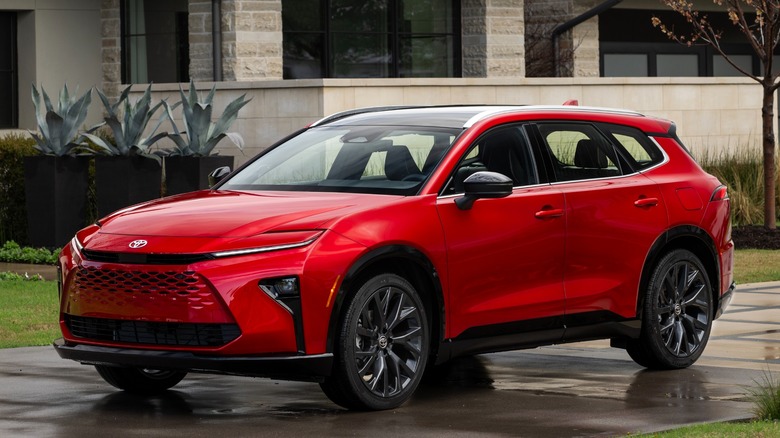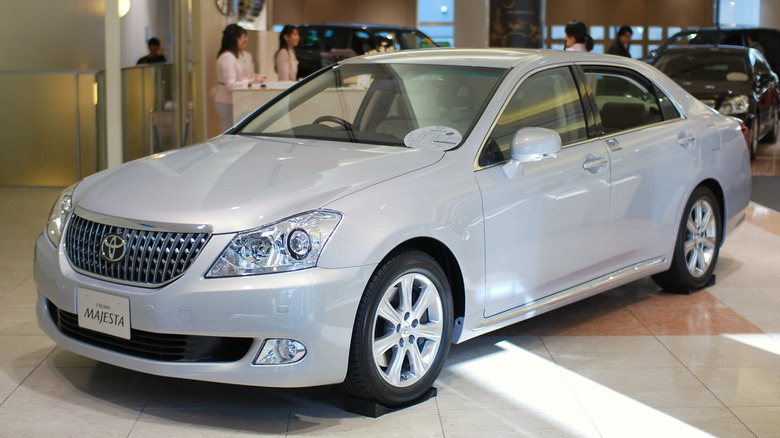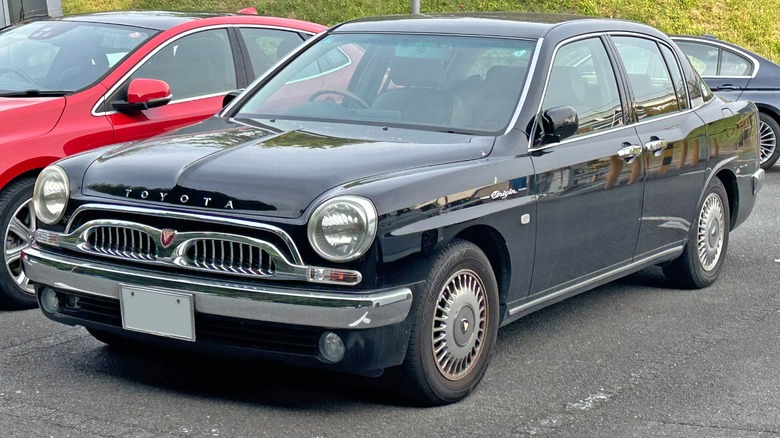10 Of The Most Luxurious Toyota Models Ever Made
When you think of luxurious Japanese vehicles, Toyota likely isn't the first name that comes to mind. That's not Toyota's fault — after all, the Japanese automaker has Lexus, which is known for making plush vehicles like the Lexus TX 350 and the ultra-reliable Lexus LS400. With Lexus looming large in popular consciousness as a maker of dependable and luxurious vehicles, you'd be forgiven for thinking that Toyota has offloaded all of its luxury aspirations to its subsidiary. Still, Toyota itself has also dabbled in luxury over its long history — although the fruits of these efforts haven't always been available in America.
Some of the nameplates on our list, like the Alphard and Century, have never been sold in the U.S., while others, like the Crown, have only recently returned to the American market after being discontinued decades ago. That doesn't mean American buyers are out of luck if they want a fancy Toyota, though, as models like the current Sequoia and new Crown Signia offer a taste of what Toyota can provide in terms of high-class interiors. Sadly, as we will see in our list, the best of the best remain tantalizingly out of reach for the time being.
Toyota Century
As far as high-end Toyotas go, the Century has to be right up there as one of the best examples of the breed. One of the many interesting Toyotas that never made it to the U.S., the Century first debuted in 1967 and was named to commemorate the 100th birthday of company founder Sakichi Toyoda.
Designed to be a conservative, restrained vehicle, the first-generation Century purred along Japanese roads powered by a 3.0-liter V8 and riding on air suspension — according to Toyota, this was the first such implementation on a Japanese passenger car. Toyota also outsourced production to Kanto Auto Works, which built each unit to customers' demands. Toyota and Kanto Auto Works got it right the first time, and the first generation lasted for a staggering 30 years before Toyota updated it in 1997.
What an update it was. The second-generation Century kept the reserved styling and premium interior — now featuring jacquard wool, crystal glass, wood paneling, and heated rear seats — but upped the stakes in the powertrain department. Gone was the V8, in its place came the only V12 to feature in a Japanese passenger car, a quiet and refined 5.0-liter unit that was paired with a four-speed automatic for the ultimate in quiet propulsion. Toyota continues to offer the Century with a third-generation model debuting in 2018 — sadly without the V12 in tow, although the rest of the car is just as premium as it's ever been.
Toyota Century SUV
The Century nameplate already carries with it an enviable heritage for Toyota, so it shouldn't surprise you that the new Century SUV is just as opulent — and equally exclusive. Meant for sale only in Japan, the Century SUV is Toyota's answer to the best luxury SUVs on the market today, not least due to its Range Rover-rivaling price, which works out to around $175,000.
While some may balk at the idea of paying that much for a Toyota, the automaker is offering a lot in return. For example, the purchasing process is every bit the equal of a bespoke European manufacturer. So-called Century Meisters stationed at various Toyota dealerships guide prospective buyers through the entire operation, recommending a configuration that best suits the buyer's needs. The Century SUV launched in 2023 in three high-gloss colors, but Toyota announced that it would eventually open up the option to fully customize the SUV's colors and features inside and out.
There's more to the Century SUV than a salesman with a fancy title, though. The Century SUV is as big as the average full-size SUV at 17 feet but only seats four, with most of the space taken up by its plush rear seats. The Century SUV's rear passengers get fully reclining rear seats, a high-end entertainment system, and something that Toyota calls a refreshment function. Access is a breeze, too, thanks to rear doors that open at a 75-degree angle, automatic steps, and C-pillar handles.
Toyota Mirai
Toyota's ambitious hydrogen-powered Mirai may be getting all the wrong sorts of attention these days thanks to a lawsuit against it from Californian owners, but its troubles don't diminish the fact that the sedan is one of the more luxurious offerings in the current Toyota stable.
The second-generation Mirai, which debuted in 2020, was a big step up from the first-generation model. It signaled a move to a rear-wheel-drive setup, based on the GA-L platform used in the contemporary Lexus LS sedan — and, befitting the Lexus links, received a comfy, high-class interior. The new Mirai featured SofTex synthetic leather material covering the heated front seats on the XLE trim, with the higher-end Mirai Limited moving to heated and ventilated front seats. Rear passengers in the Limited also had their own controls for the audio, climate control, and sunroof, so all could enjoy the ambient lighting on offer.
However, 2025 saw Toyota simplify the Mirai lineup, dropping the Limited and only offering the XLE, at least in the U.S. Thankfully, that doesn't seem to have come with a major downgrade to the interior, with reviewers praising the material quality and interior design, to the point of likening it to a Lexus interior. Toyota also brought some features from the Limited to the XLE, including ambient footwell lighting, a 360-degree external camera system, parking sensors, and heated exterior mirrors — not the final word in luxury, perhaps, but still plenty plush for a Toyota.
Toyota Alphard/Vellfire
Let's face it — minivans aren't cool, at least not if you're an American. There are only a handful of minivans left in the U.S., including Toyota's own Sienna, which has sold reasonably well in a world of SUVs and crossovers. That said, it's hardly a model anyone would associate with luxury or class, which is entirely fair. So what if we told you that, in other markets, Toyota makes a minivan that some consider to be the dictionary definition of luxury? Say hello to the Toyota Alphard and its cousin the Vellfire.
First launched in 2002, the Alphard is Toyota's top-end minivan in markets like Japan and Malaysia, where its roomy seven- or eight-seater interior is often associated with chauffeur-driven class for those with enough money to afford such luxuries. As you may expect, this isn't your average soccer mom's minivan — the Executive Lounge version of current-generation Alphard, which debuted in 2023, has motorized sliding doors and window blinds, fully reclining middle row seats covered in Nappa leather, a panoramic sunroof, and an ambient lighting system capable of 64 colors
The Vellfire launched alongside the second-generation Alphard, and the two models have existed side-by-side since. Depending on the territory, the relationship between the two models changes slightly. In Malaysia, for example, the Alphard Executive Lounge is the higher-end of the two, with the current Vellfire sporting slightly downgraded materials and a less-powerful 179 horsepower 2.5-liter engine. In Japan, however, the Vellfire gets the turbo, while both high-end trims of the two minivans have a hybrid drivetrain instead.
Toyota Land Cruiser 300
The Land Cruiser is no stranger to American audiences, with models like the 2024 Toyota Land Cruiser offering great value for owners seeking a genuinely off-road-capable SUV. That said, luxury probably isn't the first thing that comes to mind when most U.S. drivers think about the Land Cruiser. International markets, however, get the Land Cruiser 300. This is the Land Cruiser to get for those who want a bit more luxury without giving up the ability to tear up the trails over the weekend.
Priced similarly to a Land Rover Defender in markets such as Australia, the Land Cruiser 300's top-end Sahara ZX trim level costs the equivalent of $100,000. What do Land Cruiser 300 buyers get for their money, then? For one, the three highest trims — Sahara, Sahara ZX, and GR-S — get leather upholstery covering the climate-controlled seats, a heated steering wheel, and footwell illumination. They also get a 14-speaker JBL sound system and a 12.3-inch display, a feature that trickles down to the mid-range VX trim.
Toyota also equips the Sahara ZX Land Cruiser 300 with 20-inch alloy wheels, which adds a bit of exterior bling to proceedings as well. Another ZX exclusive is a hands-free back door, taking things one step above the power back door available on most of the Land Cruiser 300's trim levels. Is it the be-all-end-all of luxury SUVs? Not really, but it's a pretty swanky Land Cruiser all the same.
Toyota Sequoia
Most of the Toyota models we've looked at thus far have been sadly out of reach for U.S. buyers, so let's switch gears for a moment and look at a model that is — the full-size, three-row SUV known as the Toyota Sequoia. Now well into its second decade of life after first breaking cover in 2000, the Sequoia has come a long way since its early days, even if it continues to share a platform with the Toyota Tundra.
The latest Sequoia is still as capable off-road as it's ever been, but the higher-end trims bump up the interior tech and comfort noticeably, especially on the top-of-the-line Capstone trim. Even the mid-range Platinum trim offers an enjoyable experience on the inside, with leather upholstery all around, heated and ventilated seats for the front two rows, a 14-inch infotainment touchscreen, and a 14-speaker JBL speaker setup.
Toyota ups the ante a bit further with the $85,000 Capstone trim, which takes the Platinum's already-decent offerings and adds further luxuries such as a semi-aniline leather all round (including on the assist grips), a 10-inch head-up display as standard, automatic running boards, acoustic-laminated side windows (the Platinum only offers the lamination of the windscreen), and dark walnut woodgrain.
Capstone owners can also rest assured that other drivers will know that they've spent a pretty penny on their SUV. The Capstone adds chrome details on the side mirrors and front grille, and 22-inch alloy wheels that are machine-finished in what Toyota calls dark chrome.
Toyota Soarer
The Soarer isn't a nameplate that'll be familiar to Americans, but those of you with a keen eye will likely recognize the third-gen Soarer's swooping lines and 256 horsepower V8, which made its way to the U.S. as the Lexus SC 400. As such, it'll probably be no surprise, then, that the Soarer earns a place on this list of luxurious Toyotas — it was, after all, a JDM Lexus. We're getting a bit ahead of ourselves, here — let's turn the clock back to the first Soarer, which set the tone for the nameplate's later years.
Toyota debuted the Soarer in 1981, with the two-door featuring some then-futuristic touches like a digital speedometer and an automatic air-conditioning system, The Soarer was, according to the automaker, its first-ever personal luxury car, but we'd argue that the Soarer really got its wings starting in 1982. Toyota introduced the 2800 GT trim that year, which featured leather seats and a Technics sound system. Toyota then introduced electronically-controlled suspension to the two-seater in 1983.
The early tech wasn't the only reason the Soarer is considered an especially important JDM car. The nameplate's later models maintained the focus on a tech-infused driver's experience, with the third-generation Soarer coming with GPS from the factory. Soarer owners also had a television receiver and touch controls via the same Electro-Multivision system that the GPS used, while other quality-of-life features, such as seat position memory and a front seat that automatically moved to allow passengers to enter the rear, helped maintain the Soarer's luxury bent.
Toyota Crown Signia
Few Toyota models are as storied as the Crown. First launched in 1955, the Crown has gone through 16 generations and a whole lot of history to reach its current point, which we consider the peak — or close to it — of the nameplate's style and luxury.
This 16th generation Crown is available in four versions in Japan — a sedan, an estate, and two variations on a crossover body style called the Crossover and the Sport. Unfortunately, but perhaps not at all surprisingly, American buyers only get two of the four, in the form of the crossover Toyota Crown Signia, which is new for 2025, and the Toyota Crown sedan, which debuted in 2023. We admittedly weren't that impressed by the latter's interior at launch, but Toyota seems to have upped its game in the intervening years, as the 2025 Signia Limited earned plaudits for its interior quality when we tested it at the start of 2025.
Soft-touch materials and bronze highlights abound, along with an 11-speaker JBL system and a 12.3-inch touchscreen. Other welcome features available on both trims include acoustic treatment for the front and passenger windows, heated front and rear seats, and a heated steering wheel. It's not necessarily the most fully-equipped interior you'll ever find on a modern Toyota, but the total effect, in our reviewer's eyes, elevates the typical Toyota experience to Lexus-like levels.
Toyota Crown Majesta
As we mentioned earlier, the Crown nameplate has been around for, well, forever — or just about. So we thought it was a disservice to the name to only discuss its latest iteration. Thus, let's also look at another take on the Crown, the Crown Majesta. The Majesta was a full-size luxury sedan version of the Crown that debuted in 1991 alongside the Royal Series Crown 4-Door Hardtop. These two models joined the already-extant sedan, station wagon, and van versions of the Crown.
Much like the Soarer, the Crown Majesta was quite an advanced car for its time, with now-commonplace features such as GPS navigation, a head-up display, and computerized memory for seat, steering wheel, side mirror, and even seat-belt anchor positions. But the Crown Majesta also drew inspiration from the top-of-the-line Century, with a VIP seat (in Toyota's words) in the rear left, which had powered seat position and headrest, as well as massage and heating capabilities.
Toyota continued updating the Crown Majesta over the next decades. The 1999 Crown Majesta, for example, featured optional radar cruise control, leather seats, automatic dual-zone climate control, and refinements to the seats' lumbar support and reclining. Toyota's plush sedan stayed at the forefront of luxury for most of the 2000s, too, with later models offering premium interiors dominated by leather and wood grain, with features like motorized rear blinds and fridges all part of the equation.
Toyota Origin
Let's end our list of fancy Toyotas with arguably the strangest of them all. The Toyota Origin was a super-limited — by Toyota's standards — 2000s four-door released to celebrate the automaker's 100 millionth car. Toyota built just 1,000 or so of these Origins in 2000 and 2001, basing the special-edition car on the 2JZ-GE-powered Toyota Progrès four-door with a body from Kanto Auto Works, the same builders tasked with the flagship Toyota Century.
So, out went the Progrès' conservative exterior. In its place was a retro-minded front fascia with swathes of chrome and old-school round front headlights, chrome wheels, and — most crucially of all — suicide doors just like the original Crown. Granted, it was still a Progrès underneath, but the exterior revamp certainly made the Origin a whole lot more memorable than the car on which it was based. The interior was also similar to that of the Progrès, but with some minor upgrades befitting its commemorative nature.
The Origin's leather seats, for example, were hand-embroidered, while the wood grain received classy gold inlays that set it apart from the Progrès. It also had an analog clock to add a bit of retro style to what was otherwise a contemporary Toyota interior. The small details also extended to the car's bodywork, with the staff at Kanto Auto Works hammering out the tail fins by hand. It might not be a detail you'll feel on the inside, but we'd like to think it adds a bit of luxury mojo to the Origin.
